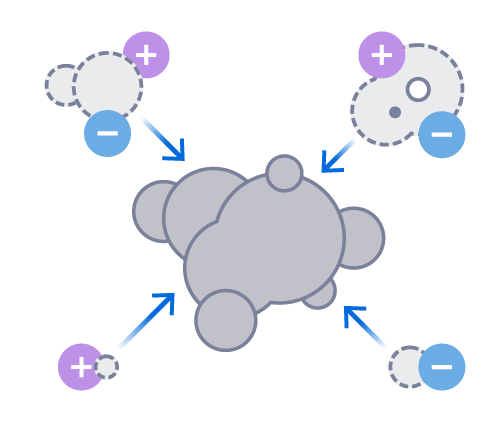How Plasma Air Technology Works
Plasma Air uses soft ionization, or bipolar ionization, technology to proactively purify indoor air at the source of contamination.
How Soft Ionization Works to Clean the Air of Pollutants
Much like sunlight does in the atmosphere, Plasma Air technology produces a natural bio-climate rich in positive and negative oxygen ions. The negative ions contain an extra electron while the positive ions are missing an electron resulting in an unstable condition. In an effort to restabilize, these polarized ions seek out atoms and molecules in the air to trade electrons with, effectively neutralizing particulate matter, bacteria and virus cells, odorous gases and aerosols, and VOCs.

Positively and negatively charged ions cause airborne particles to cluster.

Large particle clusters are caught in filters.

Bacteria and viruses bond with oxygen ions and are inactivated.

Many odorous gases and aerosols including VOCs oxidize with oxygen ions and are neutralized.
How Plasma Air Compares to Reactive Air Purification Methods
Plasma Air’s soft (bipolar) ionization technology is a superior solution because it proactively treats the air in the occupied space at the source of contamination. Traditional end-of-pipe solutions utilize a reactive “pass-through” or “filtered” approach.
|
Plasma Air |
Particle Filtration | HEPA / Fine Grain Filters1 | Carbon Filters2 | Ultraviolet3 | Biofilters | Chemical Scrubber | PCO4 | |
|---|---|---|---|---|---|---|---|---|
| Description | Soft Ionization | Pre-filters, bag filters, pre-treated filters, fiberglass filters for larger airborne particles | Captures fine airborne particles | Adsorbs and filters chemicals | Ultraviolet light kills germs and remove airborne particles | Treats exhausted air through biological media by reacting with contaminants | Treats exhausted air through chemical media by reacting with contaminants | Filtered media is coated with material that reacts with chemicals |
| Energy savings | Up to 30% | None | None | None | None | None | None | None |
| Pressure drop | Low | Low | High | Medium | None | Very high | High | Medium |
| Particle size | Small | Large(> 5um) | Small(< 0.01um) | N/A | N/A | N/A | N/A | Large |
| Treats air in room | Yes | No | No | No | No | No | No | No |
| Treats Make-up / Supply air | Yes | Yes | Yes | Yes | Yes | No | No | Yes |
| Treats return air | Yes | Yes | Yes | Rarely | Yes | No | No | Yes |
| Treats exhaust air | Yes | Rarely | No | Yes | Rarely | Yes | Yes | Rarely |
| Capital costs | Low | Low | Medium | High | Medium | Very High | Very High | High |
| O&M Costs | Low | Low | Low to medium | High | Low | Very High | Very High | High |
| Energy Costs | Low | Low | High | High | High | High | High | Medium |
| Disposal Costs | None | Low | Depends on contamination | High | Medium | High | High | High |
| Success rates5 | 99% | Low | 0-99.7% | Low | Low | Low | Low | Low |
What Are Oxygen Ions?
Ions are molecules or atoms that contain an electrical charge and exist in nature in various sizes. Small ions only last between 30 and 300 seconds before losing their charge, but are extremely active.
Small ion densities range from 900 to 1,100 negative ions and 1,000 to 1,200 positive ions per cubic centimeter (ions/cm3) in pristine natural environments. At sea level ion density is typically around 500 negative and 600 positive ions/cm3. In cities and inside buildings ion levels drop by 80% to 95% and can be barely detectable in small spaces.
As ion density decreases, so does the air quality. By increasing the quantity of both positively and negatively charged small oxygen ions, air quality is improved. This is the basis of Plasma Air's soft ionization technology.

Subscribe
Get news and updates about our latest products and offerings


